I don't have much time today as I am travelling a lot in the next…
The dreaded NAIRU is still about!
The dreaded NAIRU is still about! I was thinking – rather optimistically – that it would just disappear from whence it came! But sorry to disappoint. Some economists just won’t learn. Yesterday the ABS released the latest data from the Australia Treasury Model (TRYM) database. You can get it here. Among other things of great interest that you can find in that database, is the Treasury TRYM model’s estimates of the so-called NAIRU. Sounds scary. Well, it stands for the the Non-Accelerating Inflation Rate of Unemployment and has a central place in neo-liberal mythology. The NAIRU is an important component of the TRYM model and influences the way it produces economic outcomes and policy simulations. So how much reliance should we place on this important component of the policy making process. Answer: not much!. My conclusion: any model that relies on a NAIRU is a crock!
According to the Treasury the “Treasury Macroeconomic (TRYM) model of the Australian economy has been developed within the Commonwealth Treasury of Australia. For 25 years, Treasury has developed and maintained models of the Australian macroeconomy.” The models supports their policy analysis and forecasting work which informs final policy decisions of the Government. So, while other information and analysis is used by the Government to determine macroeconomic policy outcomes, the modelling section of the Treasury is significant. You would then want the model to be useful. I could go on at length about how its structure fails to capture the essence of a modern monetary economy but then that would be a book not a blog.
Yesterday’s data shows that the Treasury considers that the NAIRU (the unemployment rate which would deliver stable inflation) in December 2008 was 4.98 per cent (up from 4.77 per cent in the September quarter).
What exactly is this all about? In the Treasury Trym documentation. In Section 2.8, we learn that:
The wage equation is in the form of an expectations augmented Phillip’s curve. Hence, the aggregate supply curve is vertical in the long term at a level of employment and production consistent with the estimated NAIRU (non-accelerating inflation rate of unemployment). More precisely, in long run equilibrium the economy grows along a steady state growth path consistent with the NAIRU. There is a wide confidence interval around the NAIRU leading to a degree of uncertainty on the supply side
To put this in context a brief historical excursion will help. There have been two striking developments in economics over the last thirty years. First, a major theoretical revolution occurred in macroeconomics (from Keynesianism to Monetarism and beyond). Second, unemployment and broader labour underutilisation rates have persisted at high levels. In past work I have written about the development of the concept of full employment since the 1940s starting with the debate in the 1940s which emphasised the need to create enough jobs to absorb the available labour force. In the 1950s, economists quickly shifted the focus and debated the magnitude of unemployment associated with full employment based on some spurious notion that if unemployment was too low then inflation would occur. This led to the so-called Phillips curve era which was marked by policy makers contriving to achieve a politically acceptable trade-off between inflation and unemployment. The Phillips curve is “god-like” in economics and represents the relationship between unemployment and inflation as a smooth inverse curve. The underlying statistics that were used to get that curve (and since) are highly dubious. Anyway, in this period, fortuitous circumstances meant that unemployment remained low but the focus had clearly changed from generating a given quantity of jobs.
Full employment as genuine policy goal was abandoned with the introduction of the so-called natural rate hypothesis (NRH) and its assertion that there is only one unemployment rate consistent with stable inflation. In the NRH, there is no discretionary role for aggregate demand management and only microeconomic changes can reduce the natural rate of unemployment. Accordingly, the policy debate became increasingly concentrated on deregulation, privatisation, and reductions in the provisions of the Welfare State with tight monetary and fiscal regimes instituted. High unemployment persisted. The fact that quits were strongly pro-cyclical made the natural rate hypothesis untenable.
But the idea of a cyclically-invariant steady-state unemployment rate persisted in the form of the NAIRU concept, first introduced in the mid-1970s. The NAIRU was constructed as meaning that when unemployment is above it then inflation should decelerate and vice-versa. While various theoretical structures have been used to justify the NAIRU as a viable concept, the conclusion from each is simple: there is only one cyclically-invariant unemployment rate associated with stable price inflation. The NAIRU concept has dominated macroeconomic policy making in most OECD countries since the late 1970s and the “fight-inflation-first” strategies have exacted a harsh toll in the form of persistently high unemployment and broader labour underutilisation. Under the sway of the NAIRU, policy makers around the World abandoned the pursuit of full employment as initially conceived.
Of-course they couldn’t admit that so they started redefining what full employment meant. So if you read this literature you will quickly realise that the neo-liberals define full employment as being the NAIRU which is divorced from any notion that there has to be enough jobs available to meet the desires of the available labour force. So in one small change in taxonomy governments have been able to turn their failure to provide enough jobs into a success – well we are at full employment now because we are at the NAIRU. So it is a pernicious concept indeed.
In Australia, the major economic policy arms – the Reserve Bank of Australia (RBA) and the Federal Treasury have been influenced significantly by the NAIRU concept. The RBA was constituted in 1959 to maintain full employment as one of its three goals (see Section 10 of the Reserve Bank Act 1959. Subsection 2). However, since the abandonment of monetary targetting in the 1980s (the failed Monetarist experiment), the RBA has been increasingly influenced by the NAIRU concept. Until the GFC, it religiously has conducted monetary policy in Australia to meet an inflation target and, in my view, has abandoned its legal obligations to maintain full employment.
Repeated Statements on the Conduct of Monetary Policy, which set out how the RBA was approaching the attainment of its three identified policy goals, represent inflation targetting as the RBA’s primary goal. The Statements typically avoid any discussion about full employment except that price stability in some way generated full employment even though the price stability required “disciplined monetary and fiscal policy”. They justify this nonsense by claiming that although the RBA is sensitive to the state of capacity utilisation when it sets interest rates, the trade-off between inflation and unemployment is not a long-run concern because, following NAIRU logic, it simply doesn’t exist.
Under the NAIRU approach, policy makers use unemployment as a tool to suppress price pressures and the OECD experience in the 1990s and beyond shows that this strategy has been successful. The empirical evidence is clear that the Australian economy has not provided enough jobs since the mid-1970s and the conduct of monetary policy has contributed to the malaise. The RBA has forced the unemployed to engage in an involuntary fight against inflation and the fiscal authorities have further worsened the situation with complementary austerity.
How useful is the NAIRU as a guide to policy? While the topic is vast, in this blog I will just have a brief look at the NAIRU. In my latest book with Joan Muysken Full Employment Abandoned we analyse this topic in depth. So if you are looking for references or authorities for the statements I make here the book would be a good place to start. Not that I permit advertising on this blog!
The first graph shows the annual inflation rate and the official unemployment rate in Australia since March 1970 to December 2008 (using official TRYM data). The experience is common for most OECD countries. What is apparent from the graph is the disparate behaviour of the inflation rate and the unemployment rate.
It is difficult to construe an unemployment rate over the period where you would witness accelerating inflation if the actual unemployment rate were lower or decelerating inflation if the unemployment rate was higher.
To make more sense of this I constructed the following table. It uses quarterly ABS data (for the unemployment rate and CPI-based inflation) from September 1970 to December 2008 and compares the frequency of accelerating inflation with decelerating inflation for given ranges of the unemployment rate.
If there were a well-defined and stable NAIRU we would expect to find some unemployment rate range where all the changes in inflation were negative and below that range most of the changes in inflation positive. The results clearly do not support the existence of such a rate. We are unlikely to get any definitive information from the unemployment data about the likely movements in the inflation rate. In other work, I have estimated a range of so-called Phillips curve regressions, which also fail to find any evidence of a stable NAIRU specification.
I also plotted the latest Phillips curve which you can see next. While there may be stability between inflation and unemployment for a period, a sudden shock, especially from the supply side (as in the OPEC oil crisis in 1974) can worsen the unemployment resulting from a deflationary strategy, which is attempting to exploit a given Phillips curve. Evidence from the OECD experience since 1975 suggests that deflationary policies are effective in bringing inflation down but impose huge costs on the economy and certain demographic groups, which are rarely computed or addressed.
But if you study the graph you will soon see there is very little relationship between inflation and unemployment unless you are prepared to permit huge period shifts in the relationship which seem to occur around recessions. Given recessions are demand events it is hard to put a structural interpretation on the shifts. The NAIRU literature tries and fails to interpret these shifts as structural changes (workers becoming lazier; poorly crafted changes in welfare policy; less effective job search etc). All nonsense and all these explanations ultimately fail the evidence test.
So what about the estimates of the NAIRU itself. Various techniques are used to come up with this mythical time series. The TRYM model uses an econometric approach after deriving a wage equation. Others such as the OECD and many others get even dirtier and use what is known as a Hodrick-Prescott filters which is just a linear representation of the smoothed evolution in the actual data. The following graph compares the two methods with the actual unemployment rate. Before you laugh, the characters that use these synthetic series are serious!
Updated: added graph – Friday, April 17, 2009
I thought these added graphs would also help you understand how stupid these NAIRU estimation techniques actually are. Given that the NAIRU is meant to be the rate of unemployment that stabilises inflation, how would you interpret the TRYM time series in this context. Inflation ranges from some negative number to around 17 per cent over the same NAIRU value. Stupid is what I call it. But dangerous given its policy influence.
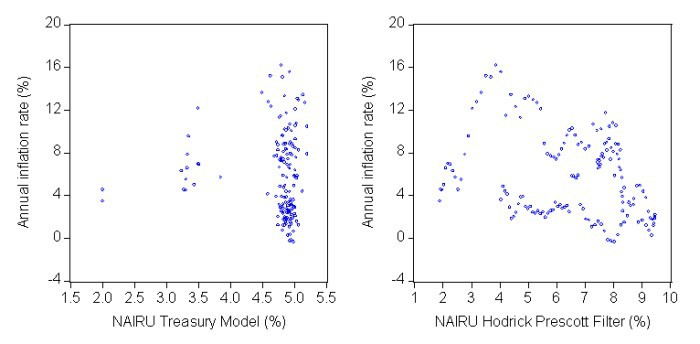
There is a huge body of evidence now that poses considerable challenges at both the both the theoretical and empirical levels for those who adhere to the NAIRU hypothesis. Here is a summary of the Non-NAIRU facts (we detail the arguments and literature in the book).
- Unemployment rates exhibit high degrees of persistence to shocks.
- The dynamics of the unemployment rate exhibit sharp asymmetries over the business cycle. There is mounting evidence against the dynamics implied by the NAIRU approach Unemployment responds to demand shocks in an asymmetrical manner. The unemployment rate rises quickly and sharply when demand contracts but persists and falls slowly when expansion occurs.
- Inflation dynamics do not seem to accord with those specified in the NAIRU hypothesis. Reconsider the graphs and table above to see this point.
- The constant NAIRU has been abandoned and replaced by so-called Time-varying-NAIRUs (just another ad hoc fudge), which have such large standard errors. The NAIRU-concept is now all but meaningless for policy analysis. The majority of econometric models developed to estimate the NAIRU are misspecified and deliver very inaccurate estimates of the NAIRU. Most of the research output confidently asserted that the NAIRU had changed over time but very few authors dared to publish the confidence intervals around their point estimates. I note that the TRYM documentation does indicate how unreliable their estimates are in statistical terms. One major study used so-called “state-of-the-art” estimation techniques and said their NAIRU estimates were imprecise. In 1994, for example, some of the 95 percent confidence intervals around the NAIRU estimates ranged from of 2.9 percent to 8.3 percent. So this range of uncertainty about the “true” value of the NAIRU is too large to be useful.
- Estimates of steady-state unemployment rates are cyclically-sensitive (hysteretic) and thus the previously eschewed use of fiscal and monetary policy to attenuate the rise in unemployment has no conceptual foundation.
- There is no clear correlation between changes in the inflation rate and the level of unemployment, such that inflation rises and falls at many different unemployment rates without any systematic relationship evident. See Table above.
- The use of univariate filters (Hodrick-Prescott filters) with no economic content and Kalman Filters with little or no economic content has rendered the NAIRU concept relatively arbitrary. Kalman Filter estimates are extremely sensitive to underlying assumptions about the variance components in the measurement and state equations. Small signal to noise ratio changes can have major impacts on the measurement of the NAIRU. Spline estimation is similarly arbitrary in the choice of knots and the order of the polynomials. Why not ask yourself: what caused the sudden arbitrary jump in the TRYM estimate in the last graph around 1974? They haven’t a coherent explantion. It is just a data fudge.
Conclusion
Its a crock! Time to move on.
Digression: Private wealth plummets
The TRYM database also contains a series Private wealth at market prices (so not adjusted for inflation). The following graph which is average private wealth per capita (so I expressed the raw data in terms of $000s per person in Australia) tells all. It peaked in December 2008 at $249, 000 and a year later it was $225,000. With the markets still in decline over the first part of this year, the next time we get an estimate (March quarter) that loss will be more than the $24,000 per person since December 2007.
Of-course, that figure includes Adults and children. If we just considered the adult population, then in December 2007, average private wealth per adult was $311,320. This had slumped to $280,669 by December 2008 a fall of $30,000 per adult or 9.8 per cent in nominal terms. Given that inflation has been running at around 4 per cent over that period, the loss is probably around 14 per cent.
To put that in context, it is the first time since June 1961 (the earliest available data) that private wealth has fallen. So these are different times indeed.
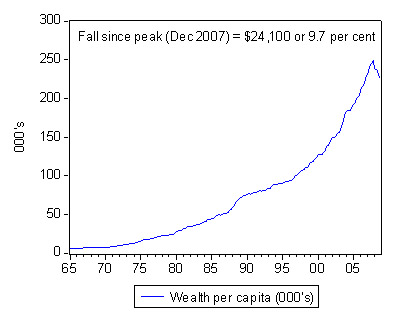
Digression: Lord Layard calls for a Job Guarantee
In the Peninsular Times, Qatar’s leading English-speaking newspaper, Lord Richard Layard called for a job guarantee. Not the billy blog JG but a bastardised, cut-down version of it. But some progress. For context, Layard is a Professor of Economics at LSE and is one of the principle architects of pernicious supply-side labour market policies which have ruled the day since the early 1990s.
You can read the article but Layard is quoted as saying it is “excellent” the the UK Government was maintaining an iron fist in terms of welfare rules, but he now thinks you need a “job guarantee” to stop long-term unemployment from becoming a bigger problem than what it already is. He proposes jobs are provided for “young people who have been unemployed for 12 months and adults unemployed for 18 months – jobs such as maintaining schools and hospitals or in social care.”
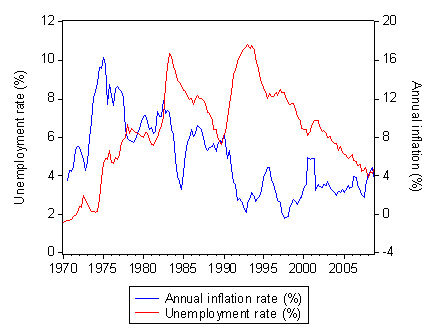
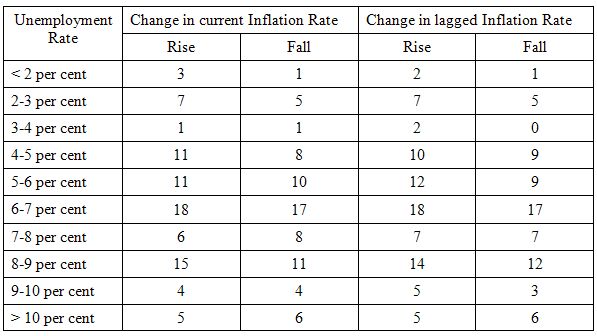
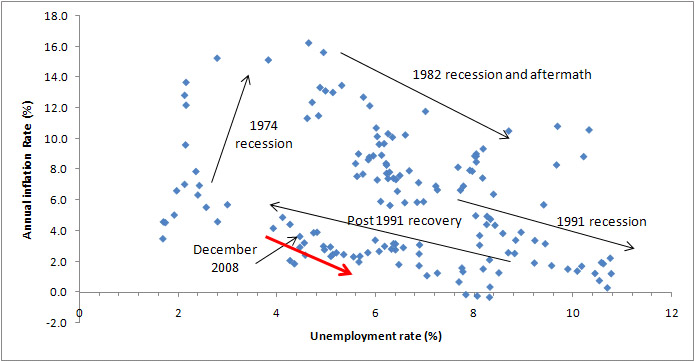
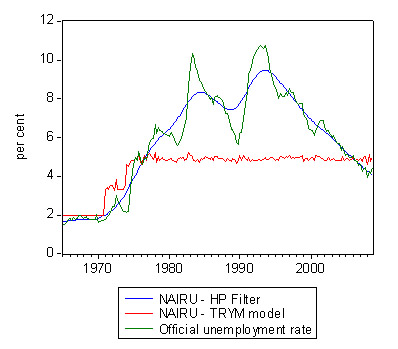
I added an extra graph today (Friday, April 17, 2009) towards the end of the post (clearly marked updated!). I think it shows you clearly how absurd the TRYM NAIRU measure is. Annual inflation has no relation with the so-called NAIRU that the Australian Treasury uses.
Have a look at “on line opinion” Bill.
A (former) adviser to the current small business minister is singing the praises of NAIRU and lower minimum wages.
With the Labor party taking advice from trained maggots like this, workers hardly need enemies.
“Time to turn down the economic turbo boost” or something, the article is called.
I’m too angry to remember properly.
Dear Lefty
Whistle a lovely tune and relax. Today we are dealing with Austrians. Tomorrow we will look into other issues.
best wishes
bill
PS: Here is the link to the article that Lefty is referring to. Read it at your own risk. It is appalling.
The data you discuss shows that (unemployment rate/NAIRU) doesn’t correlate with inflation rate. But I’d guess that is because NAIRU is dynamic, no one knows how to model it correctly, and the lag/lead factor is unknown (and possibly also dynamic). It seems obvious that true “full” employment would HAVE to be inflationary – after all, nearly everyone would like to be employed if they could pick the job of their dreams and set their own salary and conditions. But to get participation rates up close to 100% and unemployment down to 0% you’d have to be pay many of the currently non-participating or long-term unemployed way more than you or I would be willing to pay them to work for us! So getting to full employment levels would fuel inflation. Similarly, it seems self-evident that if unemployment was very high (say 25%+ or depresson-era levels) then you’d be able to fill job vacancies at very low cost (“will work for food”). Having little or no labour cost has to lower input costs, would (usually) flow on to lower retail prices, and hence provide downward pressure on inflation (over time).
If there is a considerable lag between changes in unemployment levels and inflation-affecting wage movements, then it seems that any calculation of NAIRU would have to be so retrospective that it could never be a useful tool for modelling future economic data.
I agree with “enoughwealth” above. There just has to be some sort of relationship between inflation and unemployment.
Also Bill himself seems to admit as much when he says in his “When is a job guarantee…” blog: “When the level of private sector activity is such that wage-price pressures forms as the precursor to an inflationary episode”.
The people who run our economies worship a god they call nai-ru. They believe it is only the presence of nai-ru in the world that brings prosperity and happiness. They claim to be certain that nai-ru must exist, but insist he is invisible and unknowable. Theologians have speculated about his nature, but none have ever claimed to have seen the face of nai-ru or know his true name.
Instead, the high priests of nai-ru believe that he has vouchsafed them an infallible sign that he is preparing to depart the world. This sign is when from one year to the next the oracle they call the ‘seepy eye’ rises by more than three parts in one hundred, although some liberal sects believe nai-ru will tolerate as many as four parts, while fundamentalists insist that at only two parts he will withdraw his favor.
At the first sign of nai-ru’s displeasure, the high priests know that more people must put down their tools, cease their labours, and devote their lives to the worship of nai-ru. The life of worship is a difficult one, and many will go hungry, but there is no alternative if prosperity is to be maintained.
To encourage people to devote their lives to nai-ru, the high priests work to raise the interest of the people’s governors in worship, which they do by multiplying the bonds of friendship between them. By raising the governer’s interest, they know that in turn the governors will raise the people’s interest, and the worship of nai-ru will spread. When the seepy eye ceases rising and begins to fall, they know nai-ru has been placated and will remain with us.
Sometimes, the high priests decide that the seepy eye has fallen so low that nai-ru is content, so they withdraw to their temple and let the bonds between them and the governors lapse. Interest in the worship of nai-ru declines, and some of the people return to their labours. But the priests know that they must be ever vigilant, for if the seepy eye should begin to rise they must take quick action for the good of all.
Over time, the priests have seen that the presence of nai-ru in the world is growing, and they are pleased. While the seepy eye continues to rise and fall, each time there are more and more people who remain devoted to his worship. Thus, they are confirmed in the rightousness of their work.
Let us all give thanks to nai-ru, and be greatful of his blessings.
Dear Professor,
Thank you for writing an interesting article on NAIRU. I’m curious on what your view is on how the RBA should conduct monetary policy and set the short term interest rate. Is it that you just think NAIRU is a defective concept but believe some other measures of the output gap (e.g., deviation of GDP from trend) is more appropriate or do you think the whole concept of inflation targeting or output gap targeting is wrong? Do you think the RBA should just do pure inflation targeting or should they just lower the policy rate to drive unemployment to basically zero?
You certainly make a good point that the NAIRU measures are silly on their face (especially the HP filter). But it seems reasonable that the RBA should cut rates when unemployment spikes upward and raise rates when it goes down. Perhaps you are arguing that the “normal” interest rate should be lower or do you think adjusting the interest rate down when unemployment goes up doesn’t serve any purpose.
Looking forward to hearing your (or another reader’s) reply.
Thank you for the very comprehensive article. However there is still one question I have regarding NAIRU (sorry if you have answers in your book, I did not read it yet). How would the NAIRU concept fare under different measures than headline inflation? Wouldn’t it make more sense to use either core or even better – wage inflation as basis for estimating if this or that level of unemployment is “about right”? And from the same basket – why the hell economists work with unemployment? Wouldn’t employment level – or even better, total hours worked per working age person/year fit better in this calculation?
Moreover I would like to hear your explanation of inflation as a whole. I understand the line of argument that there IS ONLY ONE and stable non-inflation-generating unemployment level – which is what you basically deny using cyclical hysteresis line of argument. But in the end – how do you reconcile such huge swings in inflation (from negative to +17%) given the same level of unemployment? Do you see inflation as totally independent from (un)employment level?
Hi Bill, I’m currently building an MMT style of model and I’m looking for a better implementation for inflation. It seems well understood that Phillip’s Curve + NAIRU is a wild guess at best, but I haven’t seen a better idea proposed to model inflation. Do you have any suggestions for different approaches to this area? Or maybe an educated guess as to how it should really work?
There is no reason whatever to assume that full employment means offering jobs to all at salaries which increase average
household income.
It is time for everyone to think out of the box. For example:
Why not begin with a national service program for every resident between the ages of 18-24 including all high school dropouts, with the following features:
1. Room and board are provided
2. Uniforms are provided
3. Health care is provided
4. Salary is $400 / month
5. 25% of participants are distributed to one of the 5 services; Navy, Army, Airforce, Marines, Coast Guard as enlistees.
6. After 2 years service, all participants are tested and the top 20% are enrolled at university on scholar ship.
7. After 6 Years service, all participants are eligible for Social Security income support at 33% of median household income
8. The sexes are separate during National Service, and all pregnancies are terminated before the 4th month.
9. After completion of national service, a citizen is eligible to vote and to marry.
10. After completion of national service a citizen who wants a tertiary education may attend a state school, tuition paid.
11. After national service or 40 quarters household income is guaranteed to be at least 33% of average household income
12. After national service and 40 quarters or 80 quarters of employment, household income is guaranteed to be at least 50% of average household income
13. After national service and 80 quarters or 120 quarters of employment, household income is guaranteed to be at least 62.5% of average household income
14. After national service and 120 quarters or 160 quarters of employment, household income is guaranteed to be at least 75% of average household income.
Unemployment, welfare, etc are eliminated as redundant.
15. Federal jobs, paying 62.5% of wages for similar employment in the private sector, during down turns, reduced to 50% during booms, are offered to anyone who wants one, and cover the full range of skill sets available.
The above can be financed by a tax on fossil fuels of at least $100/BOE, by a 10% average tax on wage income, ranging progressively from 2.5% for wages less than half of average household income, to 50% for wages more than 4 times average household income
A national single payer health system on the french model, too.
INDY
http://frappermonnaie.wordpress.com/2012/03/10/lepouvantable-nairu-est-toujours-dactualite/
Here is a translation in French of this article
I hope i’ve your authorization 😉
Above Bill wrote: “There is no clear correlation between changes in the inflation rate and the level of unemployment, such that inflation rises and falls at many different unemployment rates *without system*.”
I had to try to grok the meaning of ‘without system’ there.
I think it means — “without rhyme or reason”.
Do you think I’m right?
Dear Steve_American (at 2019/02/26 at 2:34 pm)
Thanks for pointing out the ambiguity. Your surmise is okay in fact.
I have added clarity now. I wrote that blog post in my ‘youth’ and was rather terse to say the least.
best wishes
bill
Bill, I used my engineering training to look at the 1st graph to see what it could tell me.
What I see is 2 entirely different regimes. From 1970 until ’75 they both go up and down together, a direct relationship. Then from 1975 on they have an inverse relationship.
So, I deduce that “something” happened in Aust. or the western world in about ’75.
IIRC, the OPEC oil shock started in ’73 and lasted until the late 70s or even in the early 80s OPEC was still raising oil prices because it could. So, can it be the “something”?
.
Now looking at the “updated” graph and combining it with the 1st graph to add inflation to the graph, I have to laugh. From ’75 on the red line is basically flat with just a little noise. However, changes in unemployment are supposed to be related or cause changes in inflation. So, a flat line is used to explain the ups and downs in inflation from ’75 on. Nuts.
. . . BTW — I notice that the red line is flat starting in the same year [’75] that I deduced “something” had happened to radically change a direct relationship into an inverse relationship.
. . . Bill, any ideas on just what that “something” was? It can’t be the OPEC oil shock of ’73, can it?